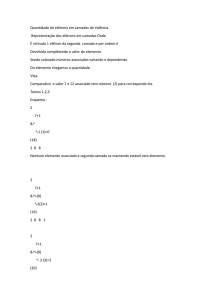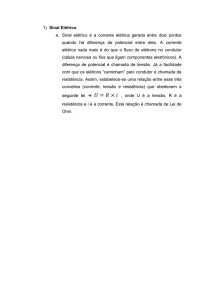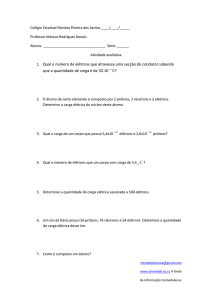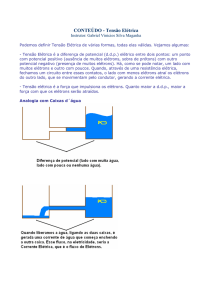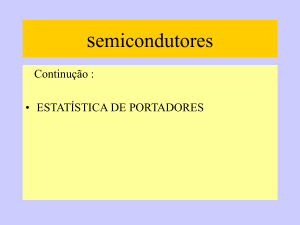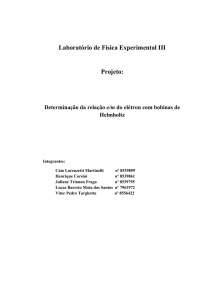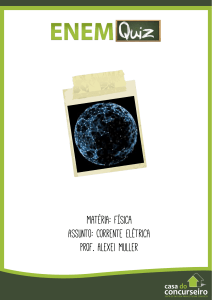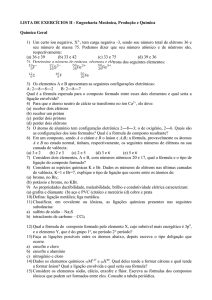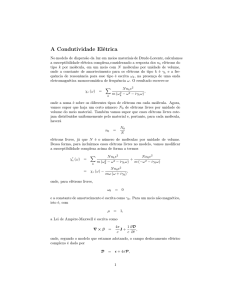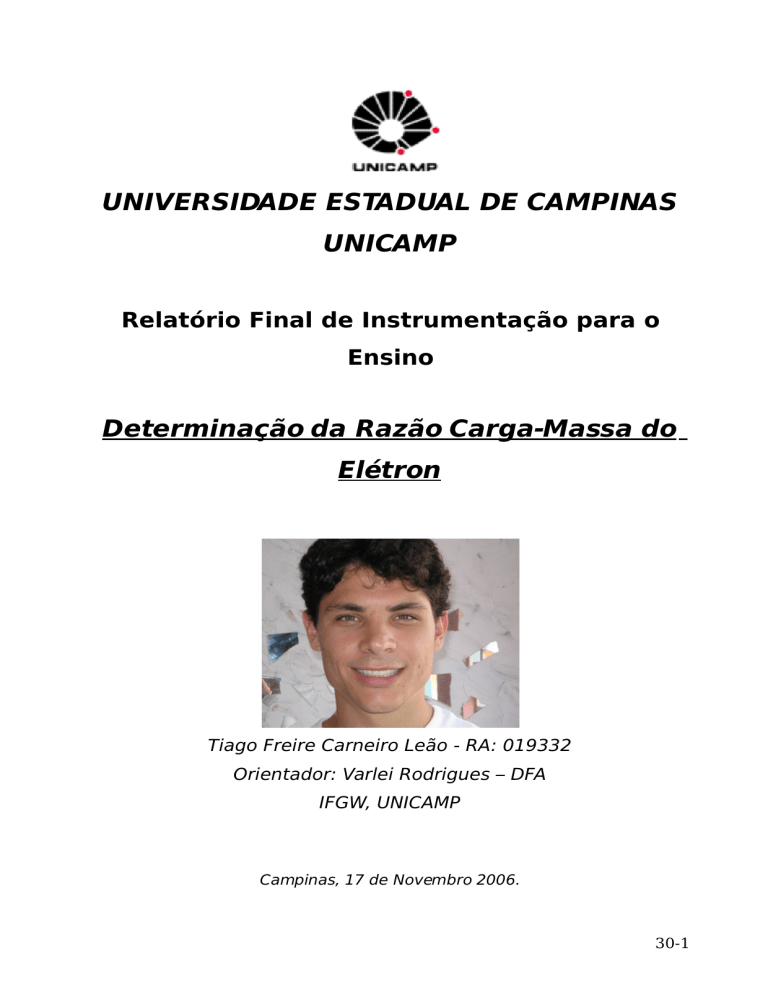
UNIVERSIDADE ESTADUAL DE CAMPINAS
UNICAMP
Relatório Final de Instrumentação para o
Ensino
Determinação da Razão Carga-Massa do
Elétron
Tiago Freire Carneiro Leão - RA: 019332
Orientador: Varlei Rodrigues – DFA
IFGW, UNICAMP
Campinas, 17 de Novembro 2006.
30-1
RESUMO
Neste trabalho demonstraremos como medir a razão carga-massa do elétron
através de um método que explora os conceitos básicos de magnetismo e
eletrostática. Este método consiste em produzir elétrons através do efeito
termiônico e então acelerá-los usando um arranjo de lentes eletrostáticas,
produzindo um feixe de elétrons. Um campo magnético uniforme, criado por
uma bobina de Helmholtz, é então aplicado na direção perpendicular ao feixe
de elétrons fazendo com que o feixe seja defletido e passe a descrever uma
órbita circular cujo raio está relacionado com a razão e/m
. Conhecendo o
[1],[2]
valor do potencial de extração no canhão de elétrons, da corrente elétrica
aplicada na bobina de Helmholtz e do raio da trajetória pode-se inferir o valor
da razão carga-massa do elétron.
AGRADECIMENTOS
Gostaria de agradecer a todos que contribuíram para o desenvolvimento e
realização desse projeto. Agradeço ao Professor Varlei Rodrigues pela
sugestão do projeto, pela paciência e atenção. Gostaria também de enfatizar
que se não fosse pela colaboração dos funcionários da Oficina Mecânica
Central do IFGW, em especial a do Jorge Luiz Pires, a realização desse projeto
não teria sido possível.
30-2
1. INTRODUÇÃO
Antes do artigo de J.J. Tompson em 1897 sobre experimentos com raios
catódicos, muitos cientistas imaginavam que os raios catódicos não eram
partículas, mas sim algum tipo de fenômeno ondulatório no Éter. Thompson
mostrou que os raios catódicos são na verdade partículas carregadas
negativamente, sendo então chamadas de elétrons [3].
Depois da descoberta de que os raios catódicos eram partículas carregadas,
Thompson disse, “A questão que surge é: o que são essas partículas? São elas
átomos ou moléculas, ou ainda matéria em um estado mais fino de
subdivisão? Para iluminar esse ponto, eu tenho realizado uma serie de
medidas da razão carga-massa dessas partículas” [4].
Em seu experimento, Thompson usou um campo magnético para defletir raios
catódicos e direcioná-los a uma fenda estreita para atingir um alvo cilíndrico.
O alvo que ele bombardeou sempre ficava carregado, não importando o
quanto os raios catódicos fossem inclinados, provando assim que as
partículas carregadas eram inseparáveis dos raios catódicos.
No experimento apresentado, elétrons produzidos pela passagem de corrente
elétrica num filamento de Tungstênio são acelerados na direção do anodo por
uma diferença de potencial conhecida entre o filamento e o anodo, adquirindo
assim uma energia cinética igual à carga do elétron, e, multiplicada pela
diferença de potencial, V.
Alguns desses elétrons escapam pelo orifício circular no anodo e entram
numa câmara de vácuo na qual uma pequena quantidade de gás nitrogênio é
injetada. A colisão do feixe de elétrons com as moléculas de nitrogênio as
promove para um estado de maior energia, fazendo com que as mesmas
emitam radiação eletromagnética na região do espectro visível após decaírem
para os seus estados fundamentais, possibilitando assim, a visualização da
trajetória do elétron [1].
30-3
Então um campo magnético uniforme é aplicado perpendicularmente à
direção de movimento do feixe de elétrons fazendo com que este percorra
uma trajetória circular. Tal campo é criado por uma bobina de Helmholtz, que
é composta de duas bobinas coaxiais com número de espiras, N, idêntico; e
separados por uma distância igual aos seus raios (Figura 1).
De fato, a força magnética numa carga Q, que se move com velocidade v
num campo magnético B, é [2]:
F mag = Q(v× B)
Esta também é conhecida como força de Lorentz. Na presença de ambos os
campos magnético e elétrico, a força em Q é:
[ (
)]
F = Q E + v× B
A energia cinética dos elétrons quando acelerados pelo potencial elétrico V é
dada, de acordo com a lei da conservação de energia, por:
30-4
1 2
mv =eV
2
(1)
O movimento típico de uma partícula carregada movendo-se num plano
perpendicular a um campo magnético uniforme é circular
, com a força
[2]
magnética gerando uma aceleração centrípeta. Pela segunda lei de Newton
podemos escrever:
F=
mv2
r
(2)
E como a única força que age sobre os elétrons é a magnética, temos que:
F = ev× B ⇒ F = evB
(3)
Combinado as equações (2) e (3), temos:
2
mv
= Bev
r
(4)
Que pode ser reescrita da seguinte forma::
v=
Ber
m
(5)
Substituindo a equação (5) na equação (1) e rearranjando os termos,
obtemos:
e 2V
=
m B2r 2
(6)
Além disso, a intensidade do campo magnético no centro da bobina de
Helmholtz pode ser calculada por [2].
30-5
B=
8μ0 NI
3
R( 5) 2
(7)
Portanto:
B=
Onde µ 0 = 4π
x
0,72μ0 NI
R
(8)
10-7 ; N = número de espiras; I = corrente pela espira; e R =
raio da espira.
Assim, combinando as equações (6) e (8) obtemos o valor de (e/m) em função
de V, I e r, pela seguinte relação:
e
3.86VR2
= 2 2 2 2
m µ0 N I r
(9)
No próximo tópico temos em detalhe a dedução do campo magnético
produzido por uma bobina de Helmholtz.
2. BOBINA DE HELMHOLTZ
[6],[7]
O campo magnético produzido por uma espira circular percorrida por uma
corrente I pode ser calculado a partir da Lei de Biot-Savart:
dB =
µ 0I dl × ρ
4π ρ 3
(10)
30-6
Onde µ 0 é a permeabilidade magnética do vácuo, ρ é o vetor do elemento
condutor dl ao ponto de medida do campo B , e dB é perpendicular a ambos
os vetores ρ e dl , como mostra a figura 2.
Como o vetor dl é perpendicular aos vetores ρ e dB , e ainda perpendicular
ao plano da figura enquanto que os outros dois vetores estão no plano, a
equação (10) pode ser reescrita como:
dB=
µ 0I
I µ 0dl
dl =
2
4π R2 + z2
4πρ
(11)
Senso z a distância do centro da espira ao ponto onde estamos calculando o
campo. Para qualquer elemento dl que escolhermos na espira a componente
dBz do campo terá sempre a mesma direção, podendo, portanto serem
somadas. Já as componentes de dBr se anulam aos pares. Sendo assim, o
campo na direção radial é nulo:
Br = 0
(12)
30-7
E o campo na direção z (axial) é dado por:
B = Bz =
µ 0I
µ I
R2
1
= 0
3
3
2 ( R2 + z2 ) 2 2R
2
2
z
1+
R
(13)
O campo magnético de uma bobina circular de N espiras é então obtido
multiplicando-se o número de espiras pela equação (13). Assim o campo ao
longo do eixo das duas bobinas idênticas a uma distância “a” do centro das
bobinas é:
B(z, r = 0) =
Sendo A1 =
µ 0IN
1
1
+
2R (1+ A2 ) 32 (1+ A2 ) 32
1
2
(14)
z− a 2
z+ a 2
e A2 =
. Quando z = 0, o campo magnético tem um
R
R
valor máximo para a < R e mínimo para R > a. A dependência de B com a
posição ao longo do eixo axial das bobinas é uniforme para o intervalo –R/2 <
z < R/2, quando a = R.
O campo B no ponto médio entre as bobinas quando a separação ”a” entre
elas for igual ao raio R é:
B(0,0) =
µ 0IN 2
I
= 0,72µ 0 N
3
2R 5 2
R
4
(15)
Onde escolhemos a origem do sistema de coordenadas o ponto médio entre
as bobinas sobre o eixo axial.
Como podemos ver a equação (15) confere com a (8).
30-8
3. MONTAGEM EXPERIMENTAL
A montagem consiste essencialmente de um canhão de elétrons, uma bobina
de Helmholtz e uma câmara de vácuo. Além disso, foi feito um suporte de
madeira para todo o sistema e uma estrutura metálica pela qual o feixe de
elétrons faz contato com o compartimento onde a trajetória do feixe é
visualizada, servindo também como suporte para a campânula de vidro.
Todo o material utilizado pode ser visto na figura 3, exceto as fontes de
tensão e de corrente e as bomba de vácuo.
Figura 3: Material utilizado para a montagem do experimento. (a) mostra na parte
superior o conjunto de anéis metálicos e rings de borracha para vedação, na região
central a plataforma metálica com as duas válvulas de ar e uma conexão com o tubo
de cobre (à direita) dentro do qual o canhão de elétrons (à direita) é inserido. (b)
Campânula de vidro e borracha de vedação que são constituintes da câmara de
vácuo. (c) Suporte de madeira com 4 pinos de aço para sustentação da plataforma
metálica. (d) Bobina de Helmholtz posicionada no suporte de madeira.
30-9
O projeto dessas peças pode ser visto nas figuras 4 e 5.
30-10
O canhão de elétrons é um componente
que produz um feixe de elétrons com
energia cinética bem definida, sendo
usado em televisores e monitores que
usam tecnologia de tubos de raios
catódicos, e em outros instrumentos
como,
por
exemplo,
microscópios
eletrônicos e aceleradores de partículas
. O canhão de elétrons é formado de
[9],[10]
diversas
partes:
um
catodo quente
(neste caso um filamento de Tungstênio)
que é aquecido devido à passagem de
corrente elétrica para gerar elétrons
livres com pouca energia via efeito
termiônico; eletrodos que geram um
campo elétrico a fim de focalizar o feixe; e por fim um anodo que acelera os
elétrons. Os elétrons são ejetados por um pequeno orifício no anodo com uma
energia cinética final determinada pela diferença de potencial aplicada entre
o catodo e o anodo
. O canhão de elétrons utilizado em uma primeira
[9],[10],[11]
tentativa e seu esquema estão mostrados na figura 6 e 7, respectivamente.
Figura 7: Esquema elétrico do canhão de elétrons
[12]
.A Capa de Wehnelt está num potencial negativo
pequeno em relação ao filamento enquanto que a diferença de potencial entre o filamento e o anodo
é o potencial acelerador.
O filamento de Tungstênio foi extraído de uma lâmpada comercial de 50 W e
12 V.
30-11
O compartimento para o canhão de elétrons foi desenvolvido de forma
independente do restante da montagem, para que seja possível desconectá-lo
em caso da necessidade de substituí-lo ou mesmo de uma apresentação
visual de seu interior. Sua conexão com plataforma metálica pode ser vista na
figura 8.
É muito importante que o experimento seja realizado num ambiente de vácuo
por duas razões. A primeira delas se refere ao filamento de Tungstênio que
pode atingir elevadas temperaturas oxidando-se na presença de moléculas de
oxigênio. A segunda se relaciona com o livre caminho médio entre as
moléculas do meio. Quanto menor o livre caminho médio (pressão mais alta)
maiores serão as colisões entre os elétrons e as moléculas antes mesmo
deles atingirem energias suficientes para ionizá-las, não havendo assim a
formação do feixe de elétrons.
Como pode ser observado tanto nas figura 3, 5 e 8, uma associação entre
anéis metálicos e rings de borracha foi feita para promover uma melhor
vedação nas regiões de conexão entre as peças.
30-12
A câmara de vácuo possui uma campânula de vidro com base circular cujas
dimensões são:
70 mm de diâmetro externo;
3,5 mm de espessura;
50 mm de altura;
O material escolhido para a campânula foi o vidro devido à sua transparência,
permitindo assim a visualização do feixe de elétrons. Também pode ser
observado que existem duas válvulas para entrada e saída de ar. Por uma
delas o ar atmosférico será bombeado e pela outra será injetado uma
quantidade pequena de gás nitrogênio.
Para produzir um campo magnético uniforme que seja capaz de defletir o
feixe de elétrons numa trajetória circular, com diâmetro compatível com as
dimensões da montagem e com energia suficiente para sobreviver ao
impacto com as moléculas de nitrogênio, tínhamos previsto que seria
necessário,
construir
uma
bobina
de
Helmholtz
com
as
seguintes
características [8]:
200 mm de diâmetro;
Número de espira em cada bobina igual a 100;
Corrente elétrica aplicada a bobina variando entre 1 e 2 ampères;
Os materiais necessários para a construção dessa bobina foram:
Um retalho de tubo de PVC com 200 mm de diâmetro;
138 m de fio de cobre esmaltado AWG 17;
5 m de borracha adesiva;
O tubo de PVC serviu como suporte as espiras de fio de cobre esmaltado. Sua
escolha foi devido a sua forma, a sua fácil obtenção e também ao fato de
30-13
resistir ao aumento de temperatura causado pelo fluxo de corrente elétrica
pelas espiras (Figura 9).
A montagem passo a passo do experimento pode ser vista da figura 10.
O
funcionamento de
cada constituinte do
equipamento foi
testado.
Primeiramente, com o auxílio de uma agulha magnetizada, constatamos que
de fato é produzido um campo magnético uniforme na direção axial das
bobinas quando uma corrente elétrica é aplicada em ambas as bobinas no
mesmo sentido, pois a agulha se apontou para a direção axial da bobina.
A pressão no interior da câmara de vácuo atingiu a ordem de 10-5 mbar
quando conectada a uma bomba de vácuo turbo.
30-14
Infelizmente, por motivos não conhecidos, não foi possível produzir um feixe
de elétrons com o canhão de elétrons apresentado acima. Para verificar a
presença do feixe, uma cerâmica fotoluminescente foi posicionada de forma
que fosse possível observar a sua luminescência em caso do feixe colidir com
ela. No entanto, esse efeito não foi observado. Então, um segundo esquema
foi montado com o intuito de detectar o feixe de elétrons. Esse esquema
consistiu em posicionar um fio condutor na possível trajetória dos elétrons e
então, através de um amperímetro, medir se houve a passagem de corrente
ou não. Novamente, nem um sinal do feixe foi obtido.
Chegando a conclusão de que o problema estava realmente no canhão de
elétrons e em virtude da falta de tempo, um novo e mais simples canhão foi
construído (Figura 11).
Um potencial negativo em relação ao filamento será aplicado no tubinho de
cobre com o intuito de focalizar os elétrons de baixa energia que serão
produzidos pelo filamento quando uma corrente elétrica passar por ele. Como
a base metálica onde esse compartimento será conectado estará aterrada, os
30-15
elétrons sentirão um potencial acelerador nessa região e emergirão através
de um orifício muito pequeno que pode ser visto na figura 8.
A seguir, podemos ver o esquema elétrico desse novo sistema.
Figura 12: Esquema elétrico da segunda versão do canhão.
O tubinho de cobre estará num potencial negativo em relação ao filamento e tem a
função de focalizar os elétrons. Como pode ser visto a base metálica funcionará
como o anodo. Apesar da base estar aterrada, os elétrons sentirão um potencial
acelerador, pois eles estão num potencial negativo em relação a base metálica.
4. PROCEDIMENTO EXPERIMENTAL PROPOSTO
Ligar a bomba de vácuo e esperar até que o vácuo necessário para o
funcionamento do filamento seja atingido;
Ligar a fonte de tensão e aplicar uma corrente no filamento da ordem
de 3 à 4 ampères;
Ligar a fonte de tensão e ajustar a voltagem no anodo em 40 V para
que energia cinética seja dada aos elétrons; Já que queremos que os
elétrons tenham energia cinética fixa, a voltagem do anodo não deve
ser alterada até o final do procedimento;
Abrir a válvula de entrada de gás e deixar um pouco de gás nitrogênio
entrar até que o feixe seja visualizado;
Ligar a fonte de corrente conectada a bobina e ajustar a corrente até
que o feixe assuma uma trajetória circular;
30-16
Varie o campo magnético variando a corrente elétrica que passa na
bobina e para cada uma delas anote os respectivos diâmetros da
trajetória;
Com esses dados trace um gráfico de acordo com a equação (9).
5. RESULTADOS EXPERIMENTAIS
Em função da complexidade do projeto e principalmente pela falha no
funcionamento do primeiro canhão utilizado, não foi possível realizar o
procedimento proposto acima. Apesar de já ter sido construído um novo
canhão de elétrons (Figura 11), ainda não foi possível testá-lo porque o prazo
para a entrega do experimento está terminado.
6. CONCLUSÃO
Tendo em vista os objetivos da disciplina, os quais englobam não somente
fatores técnicos, mas também o aprendizado e o desenvolvimento pessoal do
aluno durante esse período, pode-se dizer que a oportunidade de poder
projetar, desenvolver e executar a atividade proposta pela disciplina trouxe
um crescimento ao aluno. Isso se deve ao fato de o aluno ter tido que se
defrontar com novas experiências, que vão desde a procura por um tema de
interesse e aceitação do desafio de desenvolvê-lo dentro do objetivo
proposto, até a necessidade de procurar por auxílio de colaboradores mais
experientes que lhe deram a direção de como fazer algo nunca feito
anteriormente pelo aluno.
Com relação ao projeto e levando em conta sua complexidade, pode-se dizer
que, exceto pelo funcionamento do primeiro canhão de elétrons, a montagem
experimental ficou muito legal. Sem contar que as perspectivas são boas para
que o objetivo central, que é calcular a razão carga-massa do elétron, seja
alcançado, pois já existe um canhão de elétrons substituto.
30-17
7. REFERÊNCIAS BIBLIOGRÁFICAS
[1] http://phoenix.phys.clemson.edu/labs/cupol/eoverm/
[2] Griffiths, David J. Introduction to Electrodynamics – 3° ed. Capítulo 5,
p. 205 e 249 , Editora: Prentice Hall, Upper Saddle River, New Jersey, 1999.
[3] Morris H. Shamos, Great Experiments in Physics, (New york, Holt,
1959)
[4] Dean S. Edmonds, Ciofari´s Experiments in College Physics,
(Lexington, MA), DC. Heath and Co., 1983, pp. 373-377.
[5] http://hyperphysics.phy-astr.gsu.edu/hbase/hframe.html
[6] H.M. Nussensweig, Curso de Física Básica, Vols. 3 e 4, Editora Edgard
Blücher, 1997.
[7]
J.R.
Reitz,
F.J.
Milford,
R.W.
Christy,
Fundamentos da
Teoria
Eletromagnética, Editora Campus Ltda., 1982.
[8] Tiago F.C. Leão, Relatório Parcial da Disciplina F 809, Campinas, 2006.
[9] http://en.wikipedia.org/wiki/Electron_gun
[10] http://www.matter.org.uk/tem/electron_gun/electron_gun_simulation.htm
[11]
http://physics.csustan.edu/java/tutorials/EM/ElectronGun/ElectronGun.htm
[12] http://www.unl.edu/CMRAcfem/gun.htm
30-18
APÊNDICE
Referência [1]
CUPOL: Electron Charge to Mass Ratio (e/m)
CUPOL Home
What do these icons mean?
This lab experiment calls upon various laboratory techniques that may be unfamiliar to some students. Students needing
additional help should consult our tutorials:
Plotting experimental data | Creating a graph | Using MS Excel | Error analysis
Objective
Figure 1.
[Click on image to enlarge it.]
The objective of this experiment is to determine the electron's charge to mass ratio (e/m).
To meet this objective we will use a vacuum tube capable of producing a visible beam of
electrons as shown in Figure 1. (The beam is visible because it excites the low-pressure gas
contained in the tube.) When immersed in a magnetic field perpendicular to the beam, the
negatively charged electrons will be deflected according to the magnetic force,
.
In this experiment, we will be able to determine the e/m ratio by measuring the electrons'
potential energy and amount of deflection, and the strength of the magnetic field. Once we
have determined e/m, we will use Millikan's value for the electron charge to calculate the
electron's mass.
30-19
he Vacuum Tube
The vacuum tube is connected to a power supply and the electron beam is formed in the
following way:
An electric current is applied to the tube's filament and electrons are released from the
filament. (By increasing the current, more electrons are "burned off" and the beam becomes
brighter.) The electrons are accelerated upward toward the anode plate when a potential
difference,
, is applied between it and the cathode plate. The same power supply that
applies current to the filament also supplies the potential across the anode and cathode. In
this experiment the voltage drop is measured by a digital multi-meter (DMM), which is
connected across the anode and cathode inputs.
This potential difference imparts a change in the electrons' potential energy,
,
where is the charge of an electron. Due to the conservation of energy, this causes a change
in the kinetic energy,
. Since the electrons are at initially rest at the cathode where
the potential is zero, the conservation of energy may be written as
Eq. 1
Here, is the anode potential and the equation's right-hand side is the familiar kinetic energy
of a particle of mass, , and speed, . In this experiment the power supply may be used to
vary the anode potential, thereby altering the speed of the electrons.
30-20
he Helmholtz Coils
Once the beam is visible in the vacuum tube, the experiment may proceed. The beam is
deflected by applying a magnetic field, , perpendicular to the electron beam. Such a field is
created by a set of Helmholtz coils. Helmholtz coils are comprised of two coaxial loops of wire,
each with an identical number of turns. By definition, the coils are separated by a distance
equal to their radii.
The coils are connected to a variable current source and an electric current is applied to
the coils. It is important to note that the current travels in the same direction in each coil. The
30-21
current loops create a magnetic field between the coils. This field is oriented perpendicular to
the plane of the coils, along their common axis. In the center of the Helmholtz coils (where
the vacuum tube is located) the magnetic field is given by the formula,
Eq. 2
where is the applied current,
is the radius of one of the Helmholtz coils, and
known as the permeability of free space (
is constant
).
Each electron in the beam, then, experiences a magnetic force,
, where
is the
charge of the electron (
). In this experiment the electron velocity is
perpendicular to the magnetic field, so the magnitude of
becomes
Eq. 3
If the strength of the magnetic field is large enough (i.e., enough current is passed through
the coils) the electron beam will be bent into a circular path. The radius of the path may be
determined by noting where the beam makes contact with the surface plate. Etched onto the
plate are four concentric rings centered on the beam's exit hole. Each ring is separated by a
distance of 0.50 cm. Note that the distance between the exit hole and the beam's impact
point is twice that of the beam's radius of curvature.
Electrons moving in a circular path experience a centripetal force equal to the product of its
mass, , and its centripetal acceleration:
Eq. 4
where is the radius of the electrons' circular path. Combining Equations 1, 3 and 4 we find
Eq. 5
Using a digital multi-meter it is possible to measure the voltage drop, , experienced by the
electrons. The beam's deflection radius, , is measured visually by noting the location of the
impact of the beam with the vacuum tube's surface plate. Finally, the
magnetic field, , is determined from Equation 2 using the geometry of the
Helmholtz coils and the current applied to the wires. (The current source is
equipped with a panel meter which displays the electrical current, as shown
at the right.)
Procedure
30-22
Figure 10.
[Click on image to enlarge it.]
Exercise 1: Constant kinetic energy, variable magnetic field.
1. The manufacturer of the Helmholtz coils engraves the number of turns of each coil,
,
onto the base of the apparatus. Record this value in the Data Sheet.
Number of turns, N [0.052 Mb]
2. Measure the diameters of one of the coils and then calculate its radius, . Record the
value of the radii. In the video below, one of the coils has been removed for clarity
purposes only.
The coil diameter is measured. [0:33, 6.16 Mb]
3. Connect the power supply to the vacuum tube with wire leads being sure to match the
colors of the banana jack outlets with those of the vacuum tube apparatus. In the
video below, the black wire is connected to ground, red to the anode, blue to the
filament. (The yellow wire is connected to the grid, which helps focus the beam, but
was not used in this experiment.)
Also connect a digital multi-meter (DMM) across the vacuum tube's anode and ground
leads. The DMM will be used in step 5 to accurately measure the anode voltage.
The wire leads are connected to the vacuum tube. [0:32, 6.58 Mb]
The digital multi-meter leads are connected across the anode voltage. [0:16, 2.98
Mb]
4. Turn on the power to the vacuum tube power supply and adjust the filament current so
that the beam is sufficiently bright. In our example, the filament current is set to 0.6
amps and is held constant throughout this exercise.
30-23
The filament current is set and the beam appears. [0:22, 4.19 Mb]
5. Adjust the anode voltage,
, on the power supply to impart a kinetic energy to the
electrons. In this exercise the anode voltage is set to an arbitrary value of 38.4
volts. Since we want the electrons to have a fixed kinetic energy, the anode voltage is
not adjusted again for the duration of the exercise. You should record the anode
voltage in the Data Sheet below.
The anode voltage is set. [0:11, 2.22 Mb]
The DMM displays the anode voltage. [0.047 Mb]
6. Connect the Helmholtz coil to the variable current source with wire leads. The polarity
of the leads is not an issue. What will happen if the leads are inverted?
Leads from the current source are connected to Helmholtz coils. [0:15, 2.82 Mb]
7. In this step we will use the Helmholtz coils to create the magnetic field that is used to
deflect the electron beam. To do so, power up the variable current source and apply
enough current to the coils so that the resulting magnetic field is strong enough to
bend the beam into a circular path. The magnetic field should be large enough to
cause the beam to impact the surface plate. Record the value of the current, . Also
calculate the magnetic field strength, , and record this value in the Data Sheet.
During this step, you must measure the beam's radius of curvature, , by carefully
noting where the beam impacts the surface plate. Use the concentric circles imprinted
on the plate as reference points to help you make the measurements. Recall that the
circles are separated by a distance of 0.50 cm, and that the distance between the exit
hole and the beam's impact point is twice that of the beam's radius of curvature.
The beam is bent and the first deflection is measured. [0:41, 7.81 Mb]
All deflection measurements are played here. [1:32, 17.3 Mb]
8. Repeat step 7, varying the strength of the magnetic field by varying the current
applied to the Helmholtz coils. Take great care in measuring the electron
deflection and its radius of curvature. A small error in your deflection
measurement, say ± 0.05 cm, can cause a 10% error in your final calculation of the
electron's mass. This measurement is especially sensitive when is small.
All deflection measurements are played here. [1:32, 17.3 Mb]
The second deflection measurement may be made. [0:08, 1.51 Mb]
The third deflection measurement may be made. [0:08, 1.57 Mb]
The fourth deflection measurement may be made. [0:09, 1.81 Mb]
30-24
The fifth deflection measurement may be made. [0:09, 1.87 Mb]
The final deflection measurement may be made. [0:10, 2.01 Mb]
All deflection measurements are played here. [1:32, 17.3 Mb]
9. Use the values entered into the Data Sheet below to determine the ratio
. You can
accomplish this in two ways:
A. Determine the
ratio using measurements from each trial and then find the
average ratio. (Students with little previous laboratory experience my need to
use this method.)
B. Or you may graph the appropriate data along the x- and y-axes and then
analyze the resulting curve. The graph may be drawn by hand or created by a
spread sheet application like MS Excel, for example. (For additional help, see
our tutorials on Plotting experimental data, Creating a graph, and Using MS
Excel.)
10.In 1913, Robert Millikan determined from his Nobel Prize-winning oil-drop experiments
that the charge of an electron has a value of
. Use your experimental
results and Millikan's value to determine the electron mass, .
11.Calculate the percent error between your value for the electron's mass and the
accepted value of
.
12. For safe keeping, you may e-mail the data directly to yourself or to your TA by
entering the data into the form below and then clicking The Send Button.
Data Sheet
Exercise 1 Data Sheet
Your name:
Your e-mail address:
Number of coils,
Helmholtz coil diameter
Helmholtz coil radius,
Filament current
Anode voltage,
Current, I
(A)
Magnetic Field, B
(T)
Radius of Curvature,
r
(m)
Quantity plotted on xaxis
Quantity plotted on yaxis
Slope of your graph
Experimental value of
30-25
Accepted value of
Experimental value of
Accepted value of
Referência [9]
Electron gun
From Wikipedia, the free encyclopedia
Jump to: navigation, search
Electron gun from a cathode ray tube
An electron gun is a component that produces an electron beam that has
a precise kinetic energy, being used in all TVs and monitors which use
cathode ray tube technology, and in other instruments, eg. electron
microscopes and at the beginning of linear particle accelerators.
It is formed of several parts: a hot cathode, which is heated to create a
stream of electrons via thermionic emission, electrodes generating an
electric field which focus the beam (eg. a Wehnelt cylinder), and one or
more anode electrodes which accelerate and further focus the electrons.
Most colour CRTs (such as is used in a colour television set) are made up of
three electron guns, each one producing a different stream of electrons.
Each stream travels through a shadow mask where the electrons will
impinge upon either a red, green or blue phosphor to light up a colour dot
of a pixel of the screen, the resultant colour being a combination of these
three primary colours (including white).
Referência [11]
An electron gun is used to produce a stream of electrons with a well
defined kinetic energy. They are commonly found in all vacuum tube
applications such as TV pictures tubes.
30-26
There are two parts to an electron gun; 1) a heated filament, and 2) the
accelerating region, which is bounded by two electrodes, known as the
cathode and the anode. The filament consists of a piece of wire, commonly
made of a refractory material such as tungsten, which is heated by an
electric current. Electrons leave the surface of the filament by a process
known as thermionic emission, but with very little energy. They drift
through a small hole in the cathode, into a region where there is an electric
field, which accelerates them across the gap to the anode. They then pass
through a hole in the anode, with a final energy which is determined by the
applied voltage.
The easiest way to understand the electron gun is in terms of conservation
of energy. In crossing the gap, the electrons potential energy decreases by
an amount equal to eV. This potential energy appears as the kinetic energy
and we can write
½mv2 = eV
from which the speed can be calculated.
In this simulation, the electrons are emitted from the filament. Initially
there is no electric field between the cathode and the anode, and the
electrons just drift acroos the gap. You are however provide a means by
which you can control the applied voltage, and see the effect on the
electrons.
When you have set the voltage, click on the diagram to start and stop the
electron gun. Note that, for the gun to operate, the filament must be
heated, and glows red. Note also the direction of the electric field (from
right to left). Since the charge of the electron is negative. the electric field
must be in this direction in order to provide an accelerating force to the
right.
Referência [12]
Electron Source (GUN)
All Electron Microscopes utilize an electron source of some kind with the
majority using a Themionic Gun as shown below:
30-27
A Thermionic Electron Gun functions in the following manner
1. An positive electrical potential is applied to the anode
2. The filament (cathode) is heated until a stream of electrons is
produced
3. The electrons are then accelerated by the positive potential down the
column
4. A negative electrical potential (~500 V) is applied to the Whenelt Cap
5. As the electrons move toward the anode any ones emitted from the
filament's side are repelled by the Whenelt Cap toward the optic axis
(horizontal center)
6. A collection of electrons occurs in the space between the filament tip
and Whenelt Cap. This collection is called a space charge
7. Those electrons at the bottom of the space charge (nearest to the
anode) can exit the gun area through the small (<1 mm) hole in the
Whenelt Cap
8. These electrons then move down the column to be later used in
imaging
This process insures several things:
•
•
•
That the electrons later used for imaging will be emitted from a
nearly perfect point source (the space charge)
The electrons later used for imaging will all have similar energies
(monchromatic)
Only electrons nearly parallel to the optic axis will be allowed out of
the gun area
COMETÁRIOS FEITOS PELO COORDENADOR DA DISCIPLINA.
Projeto : Projeto aprovado. Bom trabalho!
28/08/2006
Relatório parcial: Atrasou mas a nova versão demonstra meio caminho
andado, nota 9,0
30/10/2006
30-28

